Malaysia Gasholders
The second of three large gasholders having the finishing touches applied at our Caldicot production facility before being carefully packed, crated up and shipped to Malaysia.
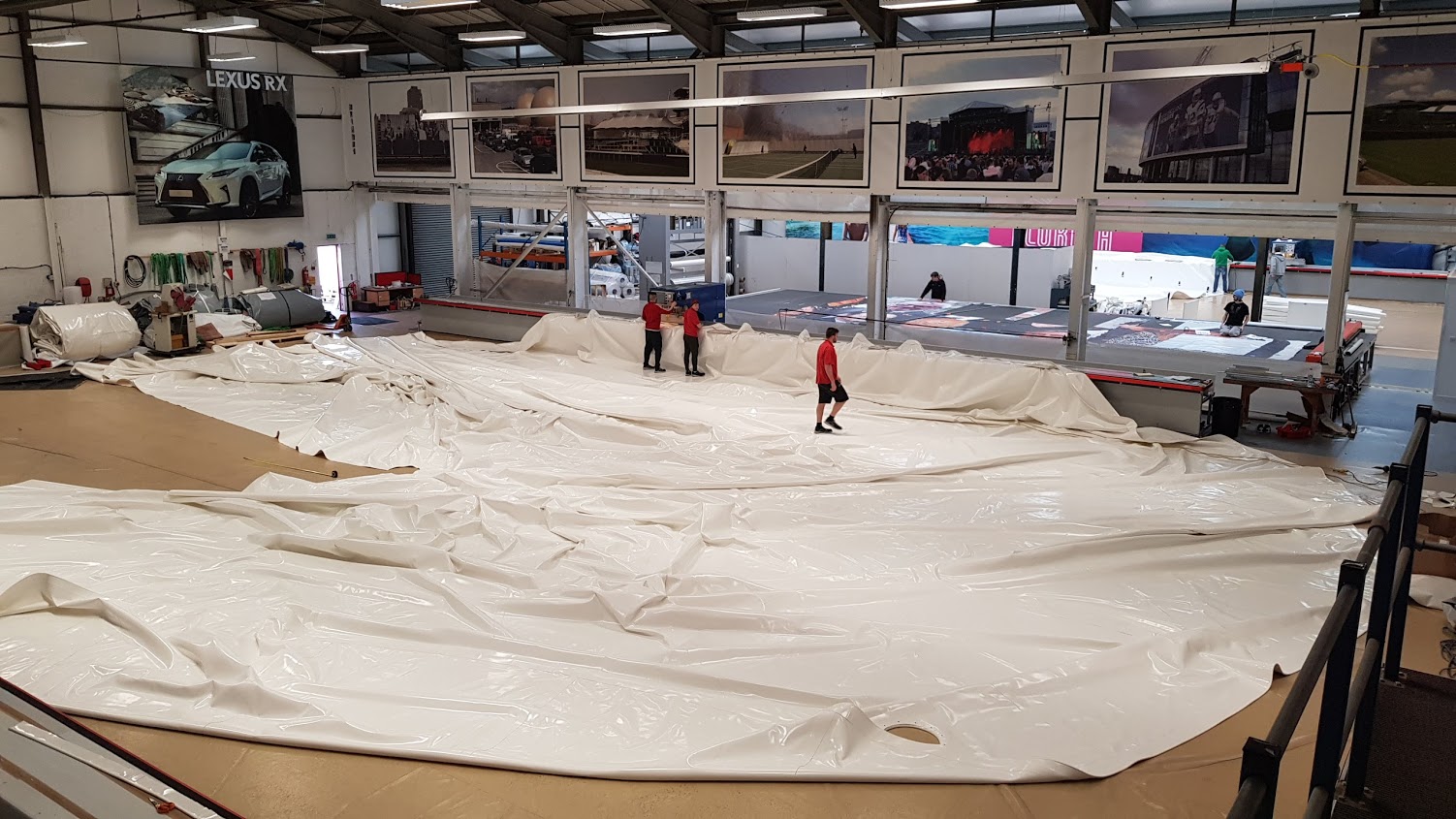
Specialists in the Cutting and Welding of PVC and PTFE Fabrics
T 01291 425 099 E office@ajtensile.co.uk

The second of three large gasholders having the finishing touches applied at our Caldicot production facility before being carefully packed, crated up and shipped to Malaysia.

Kelda Water awarded our Biogas company with the contract to replace an old biogas dome in Aberdeen that was originally installed around the turn of the millennium. This involved removal and disposal of the existing 1500 cubic metre dome, and the design, fabrication and installation of a brand new replacement, including new fans and associated hardware. AJ Tensile Biogas Systems Ltd engineered and managed the project, with sister companies AJ Tensile Manufacturing Ltd and AJ Tensile Tension Systems Ltd handling the fabrication and installation respectively. The removal and clean-up of the old biogas dome took three men three days and the installation of the new dome took three men five days, with all works completed on time and within budget.



Water and Wastewater Treatment Online reports that Welsh Water Infrastructure – a part of the not-for-profit Glas Cymru group which includes Dŵr Cymru Welsh Water – has taken ownership of a food waste anaerobic digestion (AD) and composting plant in Cardiff as part of its plans to further develop its waste and renewable energy business. AJ Tensile Biogas Systems designed, project managed and installed the fabric digester roofs, which were manufactured by sister company AJ Tensile Manufacturing Ltd.

The plant was previously owned by Kelda Water Services, is located within the company’s Cardiff Wastewater Treatment Works in Tremorfa, and already supplies the site with renewable energy. With this investment in food waste digestion on the site, around 50% of the energy used by Cardiff Wastewater Treatment Works is now generated by the company through sustainable, renewable generation.
The major advantage of anaerobic digestion is that methane, which is produced naturally when the food waste breaks down, is captured and used to generate renewable electricity and heat rather than allowing it to escape to the atmosphere from landfill sites.
This latest development comes as Welsh Water continues to expand its use of renewable sources across wind, solar, and anaerobic digestion facilities. Around 23% of the energy currently used by the company comes from renewable sources – meaning it now produces more clean, green energy than ever before. With an average energy bill of around £41 million a year, Welsh Water plans to increase the amount of renewable energy it generates to 30% by 2020 which will help the company reduce its costs and keep bills lower for customers.
Welsh Water Infrastructure Managing Director, Sonia McCorquodale, said: “Welsh Water is one of Wales’ largest energy users as the company uses a lot of energy to pump and treat water and wastewater. This latest investment will help the Glas Group to generate more renewable energy as we play our part in helping to manage the effects of climate change by becoming energy neutral by 2050.
“As a not-for-profit Group, we ensure that the gains we make go back directly into our services to benefit our customers, now and for generations to come.”
Cabinet Member for Clean Streets and Recycling, Cllr Michael Michael said: “All of our city’s food waste, which has historically been buried in landfill sites, is now treated at this plant where green energy is created from waste. As part of the sale, the terms and conditions of our contract remain unchanged and we look forward to working with Welsh Water, developing our established relationship as we both look to progress more, exciting renewable energy projects.”
As part of our strategy to cope with ever-increasing production demand, AJ Tensile Group recently upgraded our Manufacturing division’s 12kW Forsstrom HF welding machine to a 17kW FIAB 900. Part of the improvements involved mounting the FIAB to a 28m table, more than double the length of the Forsstrom’s old one.
Out with the old Forsstrom…

…and in with the new FIAB.

Our own Richard Cherry, Director of our Biogas division, is an active member of The Select Society of Sanitary Sludge Shovellers. The following article appeared in the October 2016 edition of The Environment magazine, highlighting the contributions that 5S makes both to society and to the environment.

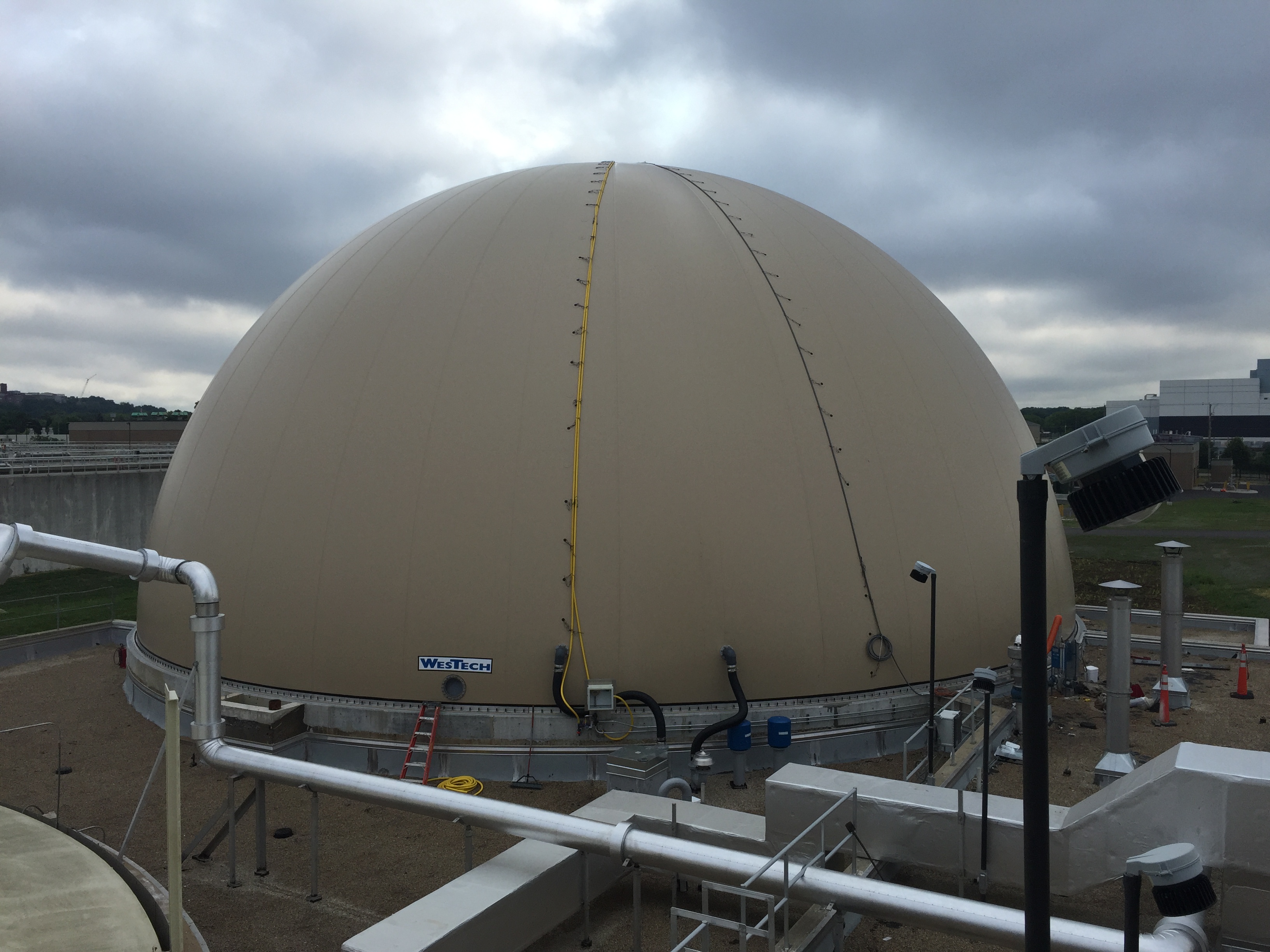
Our Biogas division recently completed this 5,398 cubic metre tank top gasholder for WesTech in the USA. Installed at Waukesha Waste Water Treatment Plant in Wisconsin, the 28m diameter 14m high dome operates at 27 millibar working pressure. The design uses our unique double-membrane construction technique, with the special tan colour of the outer membrane specially requested by the client.
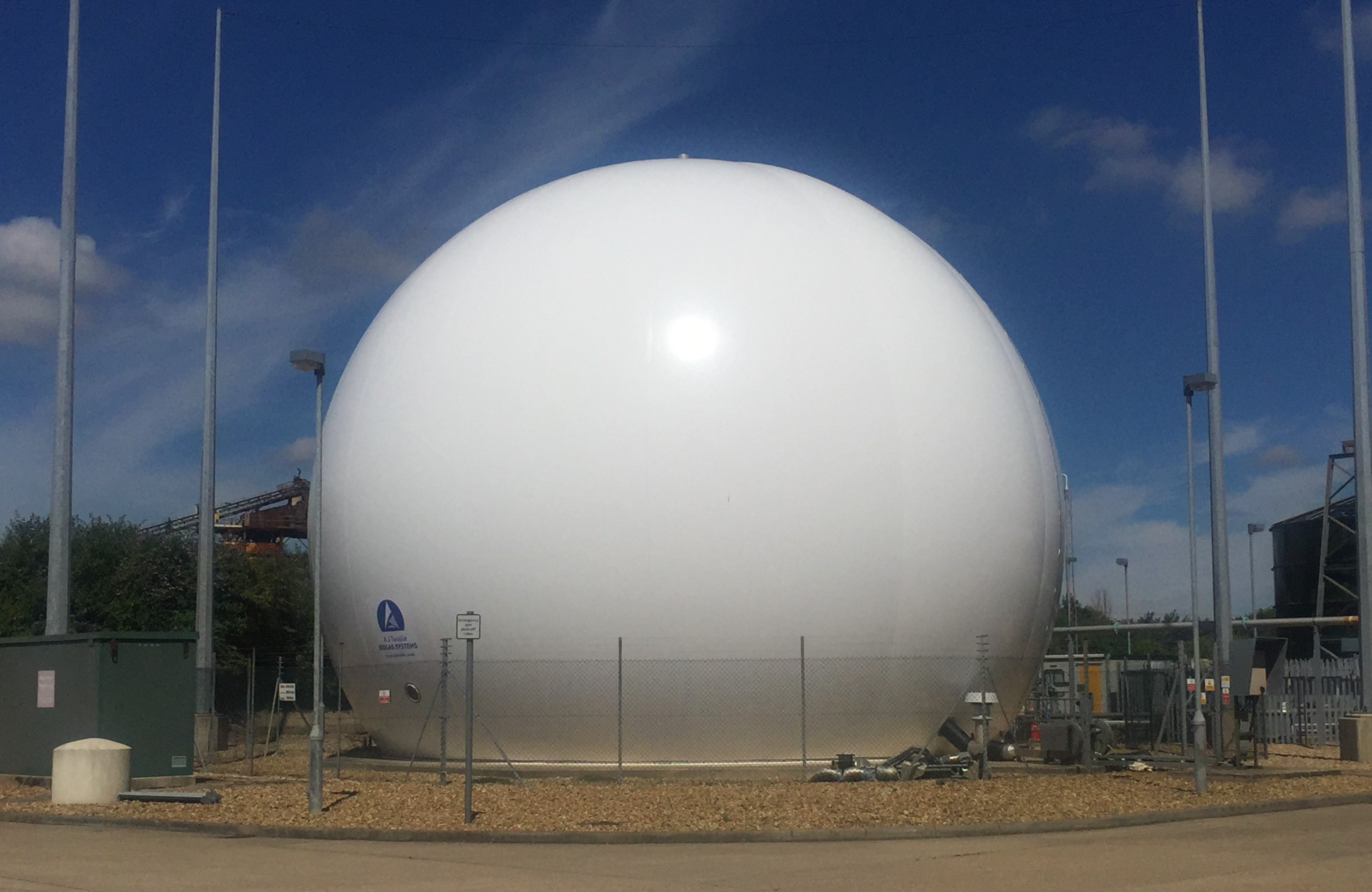
Our Biogas division recently installed this 2,100 cubic metre slab-mounted gasholder at Budd’s Farm in Havant for Southern Water and Barhale Trant Utilities. This was to replace an existing gasholder that had come to the end of its long and successful working life – a project that our Director of Engineering Richard Cherry was originally involved in.
Like most of our installations, this gasholder is bespoke to suit the client’s specific requirements, but the general design follows our own unique double-membrane construction technique. This is a tried and tested method to ensure high levels of off-site quality control and efficient on-site installation. Working pressure of this gasholder is 25 millibar.
We are pleased to report that our client and the end user are both very pleased with the final product and the whole project process.
In order to bring a better focus on its key markets and improve the high levels of service it already delivers to its customers, AJ Tensile Fabrications Limited has been divided into AJ Tensile Biogas Systems Limited, AJ Tensile Tension Structures Limited, and AJ Tensile Manufacturing Limited. These three companies all operate under the AJ Tensile Group Limited parent company umbrella.
The Biogas and Structures companies will benefit from dedicated staff with an expertise in delivering high quality projects, and will allow the skilled and experienced manufacturing staff to continue to concentrate on producing top quality products.
Biogas Systems will be headed up by Richard Cherry, one of the world’s most experienced and respected experts on anaerobic digestion and biogas storage. The Structures company will be headed up by Gary Patterson who has extensive experience of designing, project managing and installing tensile fabric structures throughout the world. Andrew Jerrum formed AJ Tensile Fabrications Ltd in 2000 and is an expert innovator of industrial fabric manufacture processes. He will head up the manufacturing operation while continuing his role of Group Managing Director.
Andrew said “the business has grown rapidly over recent years and it is increasingly evident that our staff need to become more specialised in order to continue delivering the excellent levels of products and service that our proud reputation is based on. The whole group is dedicated to making the transition as seamless as possible for all staff, customers, and suppliers”.
This website will shortly be updated to reflect these changes.
Our Director of Engineering, Richard Cherry, had the following article published in the May/June 2016 edition of Bioenergy Insight Magazine, outlining the benefits of using membrane structures for biogas containment.
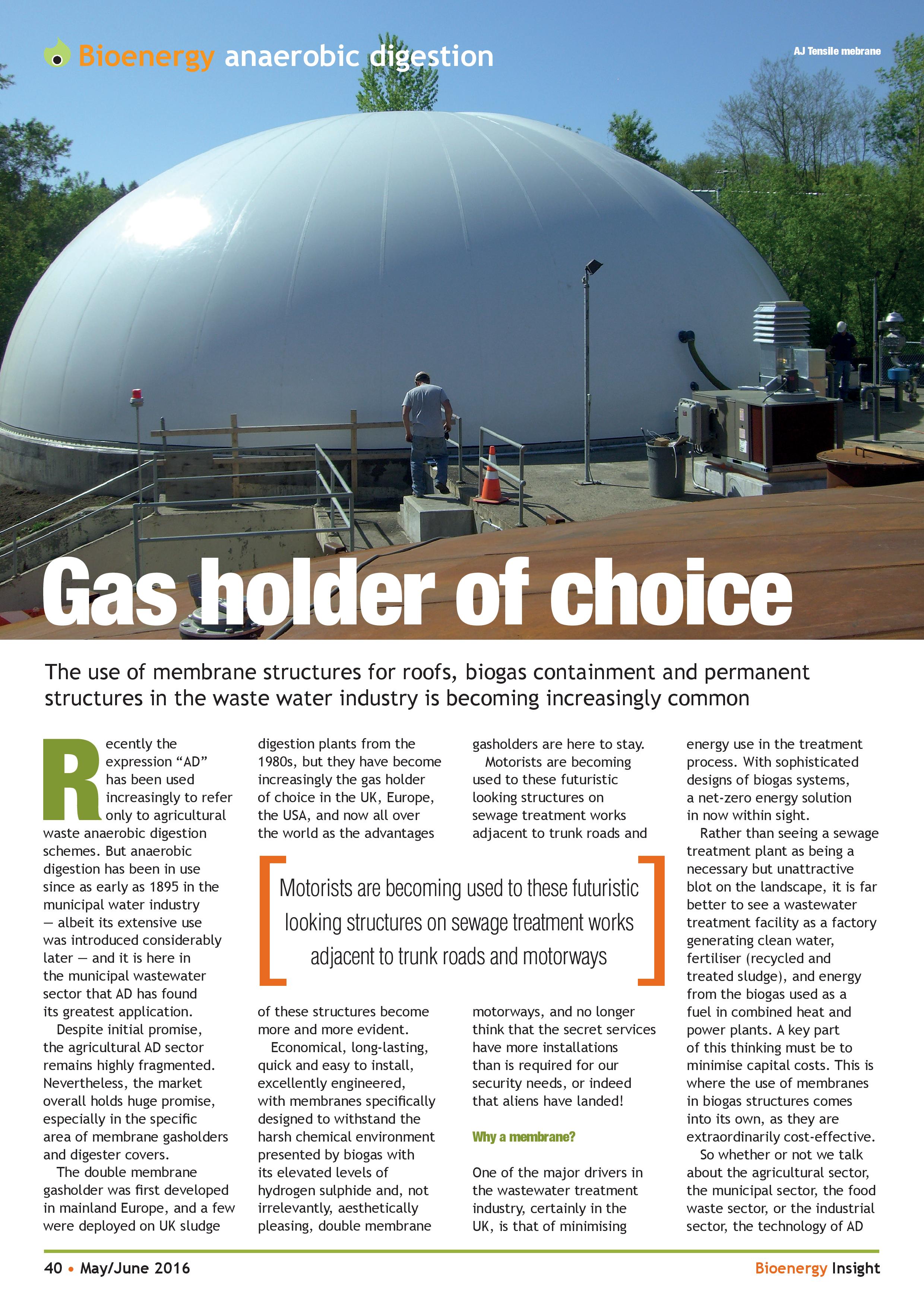
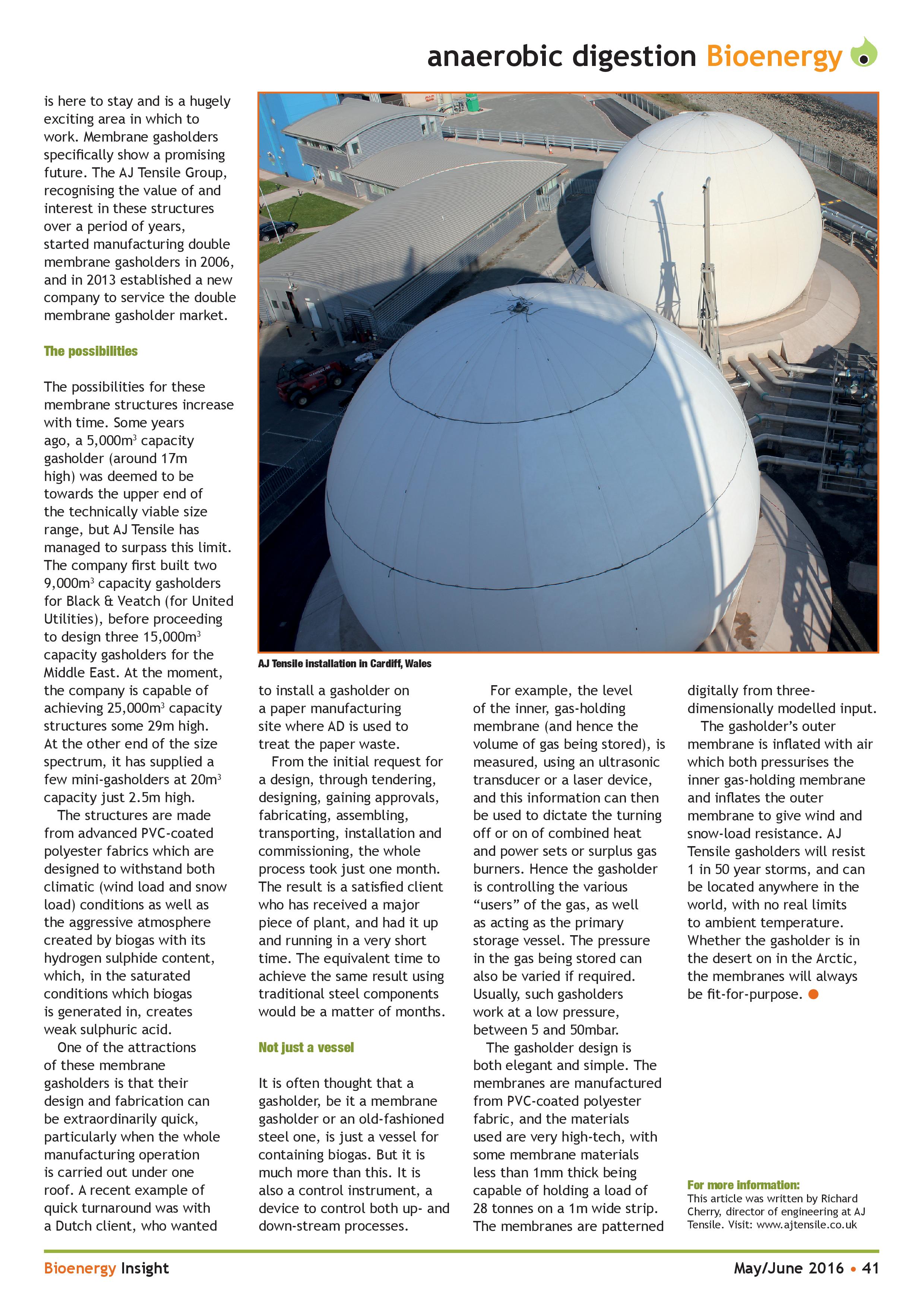
http://www.bioenergy-news.com/article_display/?volume=7&issue=3&content_item=447
A very insightful article was recently published in Black & Veatch’s Solutions Online regarding net-zero energy production at wastewater facilities. We at AJ Tensile Fabrications manufactured the two large biogas domes at United Utilities’ flagship site at Davyhulme, Greater Manchester (shown in the main photo), with senior members of our Biogas division responsible for the design and engineering.
http://bv.com/Home/news/solutions/water/net-zero-energy-in-grasp-of-wastewater-treatment-facilities

It is commonly known that wastewater possesses more energy than needed to operate a treatment facility, but the number of net-zero energy water resource recovery facilities (WRRFs) is still very low worldwide. Yet, a recent study states that the possibility of net-zero energy is now in the grasp of many wastewater facilities, and the report provides some of the best insights on record as to how to achieve such results.
The study, commissioned by the Water Environment Research Foundation (WERF), identifies approaches to reduce energy use and maximize energy production in water resource recovery facilities. The goal is to demonstrate ways wastewater treatment facilities can operate solely on the energy from the water and wastes they treat.
Stephen Tarallo, a Client Services Director for Black & Veatch’s water business, served as co-principal investigator for the project, which is titled “Net-Zero Energy Solutions For Water Resource Recovery Facilities”(ENER1C12).
“The research offers guidance for selecting the combination of technologies and energy management best practices to most effectively achieve energy neutrality at WRRFs,” Tarallo said. “We wanted to demonstrate how to maximize resource recovery through harnessing the chemical, thermal, potential and kinetic energy contained in the treated wastes.”
Real-Life Statistics and Energy Flow Models Yield Valuable Information
The study included a detailed survey of approximately 40 WRRFs in North America and Australia, which yielded valuable statistics about energy use. In addition, nine industry leaders in net-zero energy wastewater treatment were selected from the 40 WRRFs for the development of case studies to document energy management lessons learned and best practices.
According to the WERF research, energy neutrality is within the grasp of water resource recovery facilities that use the conventional activated sludge process for biochemical oxygen demand (BOD) reduction (basic secondary treatment) and nitrification. But no two facilities are alike. In fact, the research team modeled the energy flows of 25 typical WRRF configurations, ranging from basic secondary treatment to membrane bioreactors for nutrient removal and water reuse. Facility operators can use these model results to find a configuration that is similar to their plant.
The research team also investigated the energy efficiency and energy recovery performance of 18 emerging technologies and processes in a variety of treatment plant configurations. The team used combinations of best-practice and these pioneering ideas to develop 10 hypothetical model facilities that approach or exceed energy neutrality.
Best in Class of Modeled Facilities
The best overall performance was observed for a plant that consisted of chemically enhanced primary treatment (CEPT) followed by BOD-only activated sludge treatment, then anaerobic digestion, including thermal hydrolysis pre-treatment of feed sludge and co-digestion of market-available fats, oils and grease (FOG) and food waste, and combined heat and power (CHP). That facility reached an energy rating of 139 percent, meaning it met its actual energy usage plus nearly 40 percent more.
The team also developed criteria to assess the triple-bottom-line (social, environmental and financial) sustainability score of six different biosolids management options. The results showed that anaerobic digestion with co-digestion, as well as CHP followed by land-application of biosolids, had the best overall sustainability score.
For minimizing energy use, the study showed that best practices include:
The research on energy savings showed that improving primary treatment and solids capture in thickening and dewatering processes had the most significant total positive impact of all the best practices modeled.
“We found that the full combination of best practices reduces net energy use by roughly 40 percent compared to typical performance,” Tarallo said. “This is significant and demonstrates that proven technologies already exist for WRRFs to make a significant dent in their energy use.”
A Lofty but Reachable Goal
Tarallo said net-zero energy is a lofty goal that requires detailed planning and sustained commitment.
“The main challenges are different for each utility,” Tarallo said. “I would characterize the main challenge for biological nutrient removal (BNR) and membrane bioreactor (MBR) facilities as being technical – the technologies are just not sufficiently advanced at this time to confidently achieve the goal. For conventional and nitrification WRRFs, where technologies are available and well-proven, the challenges are more organizational and financial in nature.”
He said the overriding driver for success in all cases is strong leadership – a champion for the cause.
“We had the pleasure to speak with a variety of energy management champions about their utilities’ challenges and accomplishments. The passion that all of these leaders possess is infectious.”
This article was first published in Black & Veatch’s Solutions Online and is reprinted with permission.